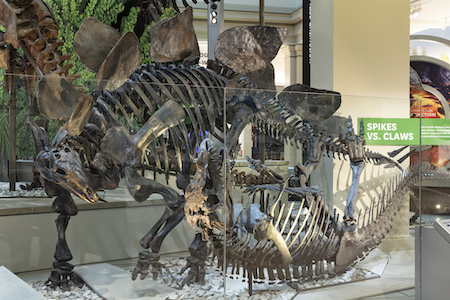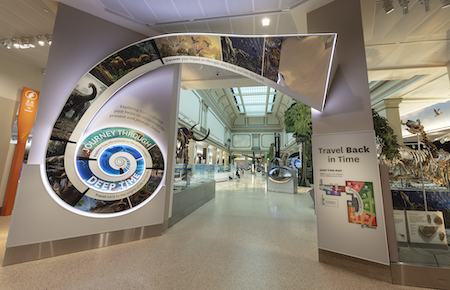
The Smithsonian’s National Museum of Natural History reopened its dinosaur and fossil hall Saturday, June 8, 2019. The 31,000-square-foot exhibition features an authentic Tyrannosaurus rex skeleton alongside more than 700 other fossil specimens, including mammals, reptiles, plants and insects—some never before displayed at the museum. The exhibition tells the story of 3.7 billion years of life on Earth, highlighting the connections among ecosystems, climate, geological forces and evolution and encouraging visitors to understand that the choices they make today will have an impact on the future. “The David H. Koch Hall of Fossils—Deep Time” is named in recognition of a $35 million gift from David H. Koch.
“Visitors to the new hall will go on a voyage like no other—a journey that begins in the past and ends in the future,” said Kirk Johnson, Sant Director of the National Museum of Natural History. “Along the way, they will experience the history of life on Earth—a story told through extraordinary fossils and engaging interactive exhibits. Visitors will also be called upon to consider the very real challenges our planet faces and their role in shaping a desirable future.”
What Is Deep Time?
What is normally thought of as history is only a tiny fraction of Earth’s actual past. Earth’s history has played out over billions of years in what scientists call Deep Time.
Main Messages of the Exhibition
Fossils are clues from the past that reveal life’s 3.7 billion-year history on Earth. The Deep Time perspective gives context to the world today and helps predict how the human species and all life will fare in the future. Major themes throughout the hall include:
- All life is connected—past, present and future—to all other life and to the Earth itself.
- Evolution: Life is continually changing through time.
- Ecosystems Change: Ecosystems changed through time and continue to do so.
- Earth Processes: Geological processes and global cycles cause ecosystem and evolutionary changes.
- Extinction: Mass extinctions have periodically devastated life on Earth.
- Age of Humans and Global Change: Humans are now shaping the future and the fate of life on Earth.
The hall is a curving chronicle of the entire history of life on Earth that shows the origin and evolution of plants and animals, recreates their ancient worlds and highlights past examples of climate change and extinction. Visitors can use the Warner Age of Humans Bridge for a panoramic view of the exhibition. They can learn about the myriad ways in which humans are causing rapid, unprecedented change to the planet in the Warner Age of Humans Gallery. This gallery was created in consultation with the museum’s Anthropocene Advisory Committee—a panel of eminent scholars, communicators and educators from nationally recognized organizations, who address human impact and climate change on the planet. Other highlights include the FossiLab where visitors can watch experts prepare fossils and the Coralyn W. Whitney Basecamp, a hands-on interactive gallery where visitors can explore the scientific process of asking questions and examining evidence.
Opening Ceremony
A celebratory ceremony will be held Saturday, June 8, at 10:15 a.m. The first 300 visitors to the museum’s Madison Drive (National Mall) entrance will be able to participate in the ceremony that will include remarks from Smithsonian Secretary David Skorton and Johnson in the rotunda.
Educational Activities and Programs
Special programming and hands-on activities will help visitors of all ages understand how Earth’s past informs the present and the future. On opening weekend, visitors can meet Scott Sampson (PBS’s Dinosaur Train), talk with the museum’s paleontologists, examine real fossils, watch fossil-themed films and combine art with science through puppet shows, costumed characters and mask-making. The museum will have extended hours throughout summer. Beginning June 8, the museum will be open 10 a.m.–7:30 p.m. daily in June (except June 20) and Thursday–Saturday in July and August (except Aug. 17).
Background on the Museum’s Renovations
The fossil hall renovation is one component of a coordinated effort to enhance visitor experience at the National Museum of Natural History. Other projects include:
- Accessible entrances: For the first time in the museum’s history, the National Mall entrance will be accessible to all visitors, including those using wheelchairs and strollers. Two new accessible walkways will be completed by the fall, one of which will be in use June 8.
- Life-size Prehistoric Shark: A 52-foot model of a Carcharocles megalodon—a giant shark that once swam in the shallow sea that covered the Washington, D.C., region—will hang in the museum’s newly renovated dining facilities opening May 24.
- New Dining Facilities: The museum’s West Court renovation will make way for new, more spacious and sustainable restaurants opening May 24.
Project Funding
The construction of the hall cost $110 million; $70 million was provided by a federal appropriation for the renovations and $40 million in private funds were raised for the exhibition itself. Additional funds were raised to support educational programming, scientific research and an endowment for the long-term maintenance of the hall. Dozens of individuals and corporations donated to the overall project including Koch, Ed and Jackie Warner, Coralyn Wright Whitney, Peter Buck, the John and Mary Brock Family, Richard L. Adams and Family, FedEx, Heather Sturt Haaga and Paul Haaga Jr., Lyda Hill Philanthropies, Elizabeth and Whitney MacMillan, Bradford M. Freeman, Nancy and Charles Hogan, Robert and Julie Mandell and Family, Gregory and Marilena Lucier, Margery and Edgar Masinter, the Moraine Foundation, Nikon Instruments, Roland and Debra Sauermann and Slash.

For more information on this museum, visit our Smithsonian National Museum of Natural History page.
Photo credit: Smithsonian Institution
Leave a Reply